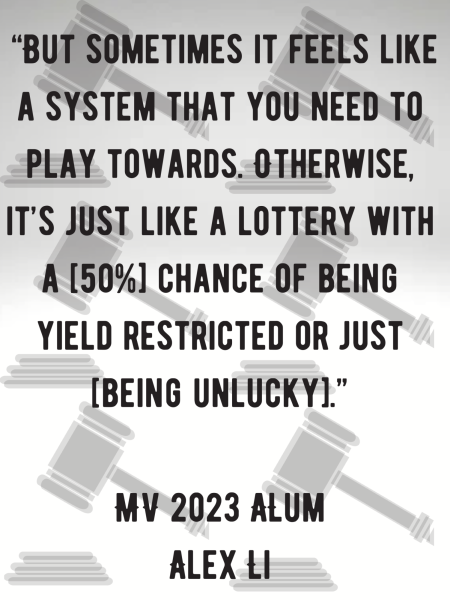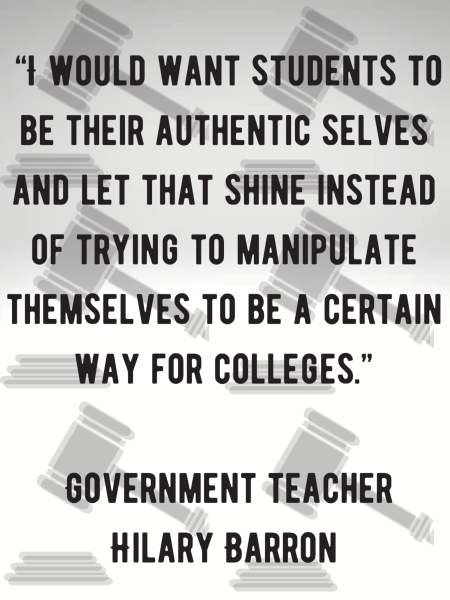The Supreme Court declared affirmative action — the practice of colleges favoring applicants from historically marginalized groups — unconstitutional on June 29, 2023. Two cases (Students for Fair Admissions Inc. v. President & Fellows of Harvard College and Students for Fair Admission Inc. v. University of North Carolina) where the use of affirmative action in colleges was challenged were settled in a 6-3 ruling in favor of Students for Fair Admissions Inc.
The Supreme Court held that affirmative action initiatives violated the Equal Protection Clause of the 14th Amendment. This ruling effectively reversed the precedents set by earlier cases, such as those involving the University of Texas at Austin, which had upheld the limited use of factoring race into the admissions process to enhance student body diversity.

Despite the decision, AP government teacher Hilary Barron points out that the ruling isn’t as simple as outright eliminating the effects of affirmative action. She notes that, while using race as a criteria for admissions is technically outlawed, students are still free to discuss their racial identity in their application materials like personal essays.
“Colleges can’t stop students from talking about their race,” Barron said. “But they can’t make their admissions decisions with race as a predominant factor. There have been past court cases on affirmative action that got rid of quotas [in the UC system] and the point system at the University of Michigan.”
According to NPR, this decision is part of a conservative shift in the Supreme Court. Barron points out that in the four years of the Trump administration, three new conservative Supreme Court justices were appointed. This provided the needed leverage to establish a solid conservative majority in high-profile Supreme Court decisions such as the overturning of Roe v. Wade and the Affirmative Action cases.
“You really don’t know about the college decision process unless you’re part of the actual admissions process,” Li said. “But sometimes it feels like a system that you need to play towards. Otherwise, it’s just like a lottery with a [50%] chance of being yield restricted or just [being unlucky].”
Former UC Director of Undergraduate Admissions Susan Wilbur agrees that the role of affirmative action is limited, mentioning that the Supreme Court decision has zero impact on California public universities such as the UC and CSU system.
“In 1996, California voters approved a constitutional amendment – Proposition 209 – which prohibited the use of race in various settings, including college and university admissions,” Wilbur said. “Beginning with admission to the fall 1998 term, California public institutions have not used affirmative action in admissions.”
While affirmative action hasn’t had a place in California’s public universities since 1998, the same cannot be said for other universities. Barron, who teaches about the history of affirmative action as part of AP Government civil liberties unit, talks about the reasoning behind affirmative action.
“If the government is going to discriminate based on race, there has to be a really good reason for it [because of the Equal Protection Clause],” Barron said. “But they’ve upheld using race as a consideration in college admissions in [Fisher v. University of Texas]. Historically, this has been one area where we can discriminate between people based on race, and opponents of that call that reverse discrimination [because it] disproportionately affects white and Asian Americans.”
For future admissions, Wilbur states that all universities and colleges are no longer permitted to use affirmative action as part of their review and admissions process. However, in a statement from University of California president Michael Drake directly following the overturning of affirmative action, the UC system remains dedicated to the promotion of diversity in high education and is willing to offer its help to universities adapting to the change.
The decision necessitates that universities adopt new strategies that do not rely on race and ethnicity as metrics. As a result, many institutions may look to models already in practice like the UC system’s approach with their comprehensive review. Wilbur expresses that the UC system has utilized a variety of practices to help encourage diversity on its many campuses. For example, one of these programs —- the Eligibility in the Local Context program (ELC) ‚—- draws from students performing within the top 9% of their respective high schools.
“Specific to the University of California, at the freshman level, all campuses use multiple measures of achievement and promise while considering the context in which each student has demonstrated academic accomplishment,” Wilbur said. “This policy, referred to as comprehensive review, states that each UC campuses consider not only an applicant’s grades and test scores, but also their life experience, neighborhood and school characteristics, qualifications for the Eligibility in the Local Context program, any recent and marked improvement in academic performance, outstanding performance in a single subject area, and special talents or skills.”
These policies were initially designed to help the UC system promote diversity when affirmative action was banned in the California state legislature. However, Wilbur notes that while these policies did attempt to alleviate issues with racial disparities on campus, there is only so much that could be accomplished through race-neutral measures.

“UC implemented a number of race-neutral initiatives intended to increase student body diversity including comprehensive and holistic review policies,” Wilbur said. “The Eligibility in the Local Context program expanded outreach efforts. The University also eliminated legacy preferences in admission in 1998. Yet, while these measures have been beneficial, they have been inadequate to meaningfully increase student body diversity.”
Wilbur adds that while the numbers of minority applicants have increased in recent years, these gains in enrollment and diversity tend to congregate among the less selective UC campuses. This pattern raises questions about the effectiveness of current strategies in not only attracting but also distributing diverse student bodies across all levels of the UC system.
Li, on the other hand, argues that the problems with diversity in higher education extend beyond affirmative action. He identifies systemic oppression and underrepresentation as more pervasive issues that affect educational opportunities for underprivileged communities. Li further adds that new solutions need to address the foundational causes of inequality rather than merely adjusting admissions policies.
Regardless of changes to affirmative action policies, both Li and Barron encourage students to remain authentic to themselves and “go with the flow” in the college admissions process. They express that in the end, it’s compelling stories and passion that remain the most important factor to a healthy and fulfilling college application season.
“I would want students to be their authentic selves and let that shine instead of trying to manipulate themselves to be a certain way for colleges,” Barron said. “I would hope that they are not trying to act or pander to what the colleges want but to just go with what their passions are who they feel like they are and where they want to go with the colleges since I feel like that is the most compelling.”












